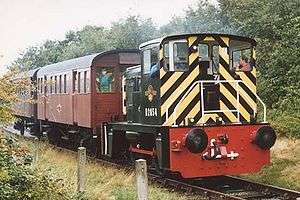British Rail Class 02
The British Rail Class 02 were a class of twenty 0-4-0 diesel-hydraulic shunting locomotives built by the Yorkshire Engine Company in 1960 (first ten, D2850-D2859) and 1961 (D2860-D2869) for service in areas of restricted loading gauge and curvature such as docks. They had the door to the cab at the rear, with a railed veranda behind the cab; this feature was very unusual on British Rail locomotives although was used on many Yorkshire Engine Co. designs and was/is quite normal in North American practice.
| British Rail Class 02 | |||||||||||||||||||||||||||||||||||
|---|---|---|---|---|---|---|---|---|---|---|---|---|---|---|---|---|---|---|---|---|---|---|---|---|---|---|---|---|---|---|---|---|---|---|---|
 D2854 on the Middleton Railway in 1994 | |||||||||||||||||||||||||||||||||||
| |||||||||||||||||||||||||||||||||||
| |||||||||||||||||||||||||||||||||||
| |||||||||||||||||||||||||||||||||||
| |||||||||||||||||||||||||||||||||||
Operation
Initial deliveries were to Bank Hall shed in Liverpool[1] and most were allocated to Depots around Liverpool or Manchester.
Withdrawal
With the changes in the role of the British railway system and the closing of many of the facilities in which the Class 02 locomotives worked, they were increasingly surplus to requirements. The first locomotives were withdrawn in December 1969 from the Preston division of the Midland Region[1] and by the end of 1971 there were only four left in service with British Rail. Of these, three survived long enough to enter the BR TOPS computer system: 02 001 (formerly D2851), 02 003 (D2853), and 02 004 (D2856), and all three were withdrawn in June 1975 from Allerton depot.[1] Being between nine and fourteen years old when withdrawn, they still had a lot of life left in them, and the majority were sold to private industry, with nine being cut up for scrap.
| Year | Quantity in service at start of year | Quantity withdrawn | Locomotive numbers | Notes |
|---|---|---|---|---|
| 1969 | 20 | 5 | D2861–63/68–69 | D2862 and D2868 sold for industrial use. |
| 1970 | 15 | 10 | D2850/54–55/58–60/64–67 | D2854, D2858 and D2865-7 sold for industrial use. |
| 1971 | 5 | 1 | D2857 | |
| 1972 | 4 | 0 | - | |
| 1973 | 4 | 1 | D2852 | Allocated TOPS number 02 002. |
| 1974 | 3 | 0 | - | |
| 1975 | 3 | 3 | 02 001/03–04 | 02 003 sold for industrial use. |
Preservation
There are 7 locomotives now in preservation, where their small size makes them perfect as a workshop shunter or for use in track maintenance work. One (D2860) is the works shunter for the National Railway Museum in York, where it is used to move much larger exhibits around.
- D2853 by Barrow Hill Engine Shed
- D2854 by Heritage Shunters Trust
- D2858 at Midland Railway – Butterley
- D2860 at National Railway Museum, York
- D2866 by Heritage Shunters Trust
- D2867 Diane at Battlefield Line Railway
- D2868 by Barrow Hill Engine Shed
Technical details
The engine is a Rolls-Royce C6NFL176 6-cyl. in-line connected to a Rolls-Royce series 10,000 3-stage twin-disc torque converter and a manually operated YEC reduction and reversing final drive gearbox. The engine and transmission are mounted at an angle of 30 degrees to the horizontal to allow the overall length and height of the locomotive to be reduced.
Unlike most earlier British Rail shunters, the Class 02s were built with train vacuum brakes.
Industrial locomotives
In addition to these locomotives produced for British Railways, around 50 very similar locomotives (most with diesel-electric transmission and/or more powerful engines) were produced for industrial customers. Many of these can now be found in preservation also, since few industrial users have their own railways anymore. Quite a few are dressed up in fictitious British Railways livery and numbering (for example - 02 101).
Notes
- A Decade After. Midland Railfans.